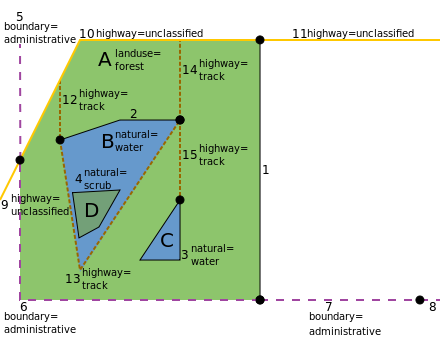How to map landuse
This page presents basic and advanced techniques for mapping objects with the properties landuse=* and natural=*.
Definition
landuse=*-tags describe the major usage of humans of their environment (civilisation). Analogue to this, an area with natural=* describes the features of natural origin within that area.
Level of refinement
Highways
...are only represented by ways. The landuse/natural is deduced from the neighbouring areas.
Schools/Kindergartens
... are represented by an area tagged amenity=school/amenity=kindergarten. The landuse of the school/kindergarten area is determined by the surrounding landuse.
Universities
Shops
If there are shops existing in an area, but the major usage of it is for residential purpose,
Values
Explanation: There are different levels of abstraction within OSM. highways are in general represented by ways (i.e. they are abstract). Those
Frequently asked questions & common mistakes
Can I use both, landuse=* and natural=* on the same closed way?
- Yes. Usage by humans is orthogonal to what natural features exist within that area, even if there is a weak connection.
Do I have to add natural=wood to landuse=forest?
I want to give a settlement a name. Can I tag it on the area with the landuse?
- This is a case for a
place=*-tag.
- This is a case for a
Does the amenity area of a school/university have to be excluded from surrounding landuse (e.g. residential)?
- Since the area marking the school is not used for the specific landuse (e.g. residential), it should be excluded.
On which areas is it possible to add landuse=retail?
- Areas which are mixed with residential/commercial since some shops exist in the ground floor and of course locations which are only used for retail. It is not necessary to compare the number of shops with the number of flats.
Since a park is already marked using leisure=park is it still necessary to add landuse=recreation_ground?
- No.
landuse=recreation_grounddescribes an area where sports is the predominating land use.
- No.
How should a track with a grass surface be mapped?
Using multipolygons

The most advanced methods to map landuse/natural are to use relations of the type multipolygon, where many times barrier=* is applicable to (parts of) its border way.
Islands
A native application of multipolygons is for example the case of an island in a lake.
The only way to map a named lake and an island within it is to include both ways with the roles outer and inner into a relation. The relation is tagged with type=multipolygon, the lake is tagged with natural=water,name=* and the island is tagged with landuse=*/natural=*.
Sharing ways
Neighboured ways of landuse-areas share many nodes. To avoid to create two long ways sharing partially the same nodes, describe the areas with multipolygons which collect all outer and inner ways including the way shared by both areas. Because landuse=* is always an area and can therefore only be applied on closed ways, the relation has to wear the landuse-tag.
Analogue to border-relations exclaves are able.
Tip: The most editors provide a shortcut-key to cut ways into smaller pieces.
Highways as outer and inner
In many cases the landuse on one side of a street differs from that on the other side. In those cases the highway can be cut into pieces as required. The required pieces can be put into the relation with the roles inner or outer.
Attention: Before cutting highways into pieces assure that it is member of a relation of the type street or associatedStreet.
This section is discussed at Discussion and not yet decided.
GB discussion on the mapping of landuse & landcover
In March 2021 the subject of how to map land cover & land use features, in relation to adjacent highways was discussed on talk-gb[1]. There was a wide ranging discussion, but no clear consensus about how the features should be mapped. Where those features border with a highway, the mapper should avoid using shared nodes if possible.